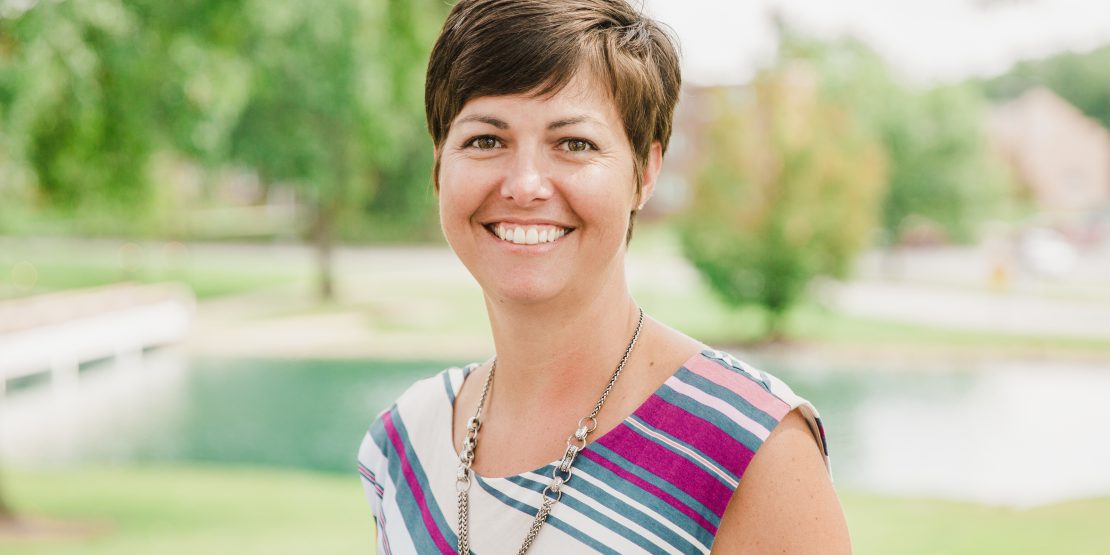Dr. Carrie McCray
Professor, ASL Interpreting; Associate Dean of Academic Assessment; William Woods alumna (bachelor’s degree and master of education)
Expertise: Educational Interpreting, Ethics of Interpreters, Mental Health Interpreting, and Performance Interpreting
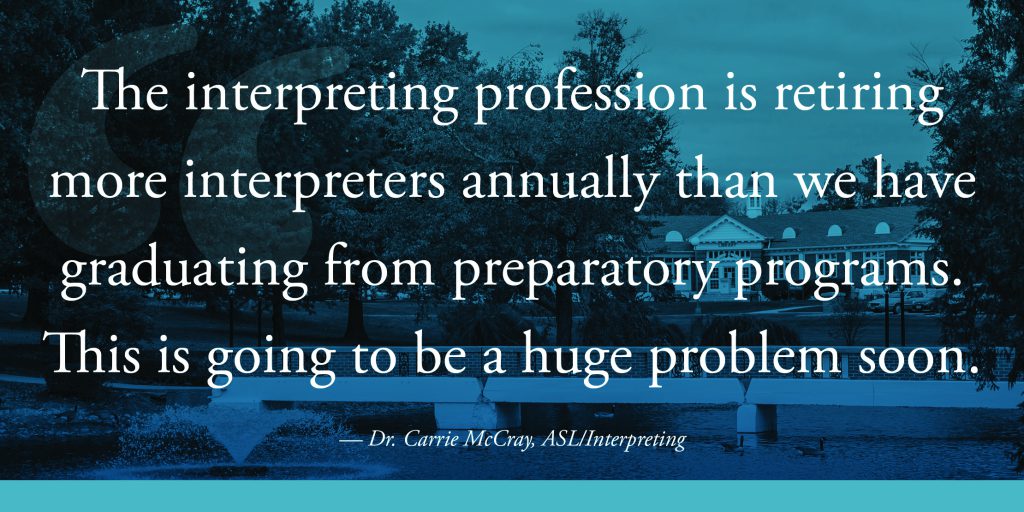
From Oklahoma to Fulton
I’m from a small town in rural Oklahoma, with lots of farmland, two traffic lights, and a high school graduating class of 48. My parents encouraged my sister and me to explore higher education options outside of the state. I learned about William Woods through my sister, who came here for the Accounting program. I visited her numerous times and fell in love with the campus atmosphere.
You can’t come to campus and NOT feel comfortable.
I decided on a career in ASL because I wanted something that would be interesting and offer a lot of day-to-day diversity. William Woods’ ASL department had just received a grant to grow from a two-year associate’s degree to a four-year bachelor’s program. It was a great fit.
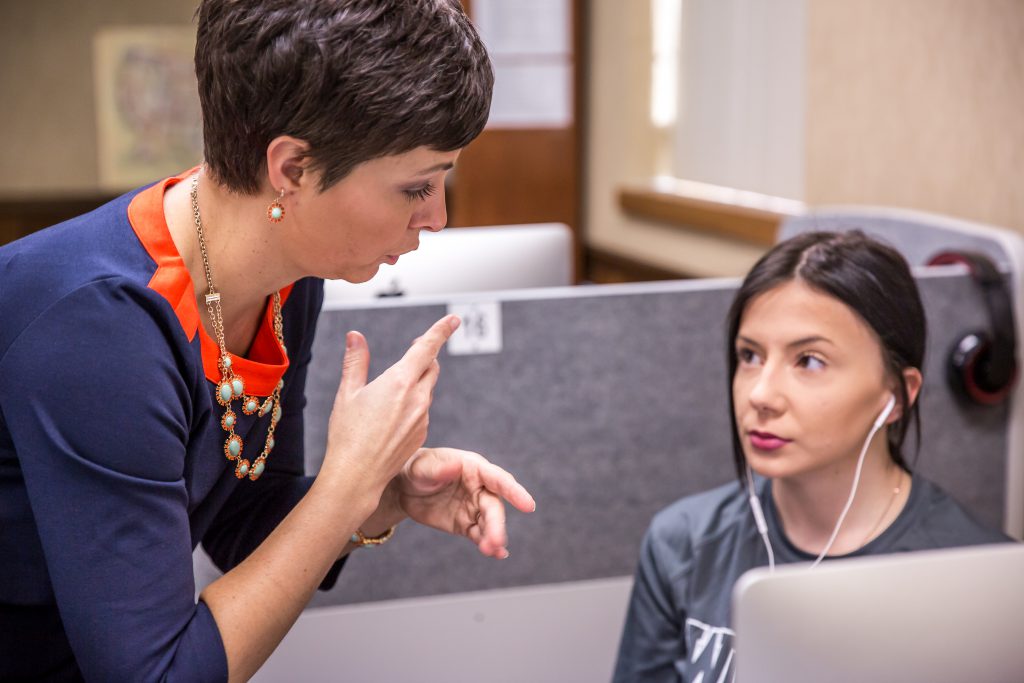
William Woods Memories
I loved every minute of my collegiate experience — enough that I threatened to fail my last semester so that I could stay in school a bit longer. Needless to say, my parents were not in agreement with that decision, so I graduated. But I loved school.
I was at William Woods when it was still all women. Because the Interpreting major was an adult program at that time, most of my classes were in the evening. I was able to take my General Education and Psychology courses during the day and my Interpreting courses in the evening.
We were an all-women’s campus, but that does not mean that there were no men in our classes. We had students from nearby Westminster College in our classes all the time, taking Education and Art courses, and I took some of my Psychology courses over there, so there was a lot of interaction between the two campuses. This was true on the socializing front of things too.
Campus was not that different than it is now, except for we wore flannel pajama bottoms to class instead of yoga pants!
I mentioned that the Interpreting program was an evening program. This spread out my coursework but set up prime opportunities to volunteer at the Missouri School for the Deaf, here in Fulton. I was able to volunteer extensively with a Deaf teacher there and give back to the community that was teaching me the language that would be the basis of my professional employment.
I have so many good memories of my time at WWU, but it is hard to separate my time as a student and an employee. I have stayed in touch with so many students over the years, and my experiences with them also highlight my time here at WWU. I was in Delta Gamma as a collegian and worked with the chapter as an adviser for almost 15 years. I have worked closely with Interpreting majors and then maintain a connection with them as they become colleagues.
As a student, one of my favorite memories was waking up to almost 21 inches of snow! Campus was shut down and the drifts were so high we had to climb out the windows to our residence hall. We built a giant “snow” boat, as we were at the Delta Gamma house. We played cards, ate junk food, and had such a great time that we still talk about that snow storm when we come together again at Alumni Weekend.
Now, as a faculty member, some of my favorite memories revolve around students and the successes that they have accomplished. Interpreting is such a close-knit profession that I could tell you where most of our students are located from the past 15 years.
Being a part of students’ development in this profession is my way of giving back to the Deaf community that gave me the gift of American Sign Language.
Becoming an Interpreter
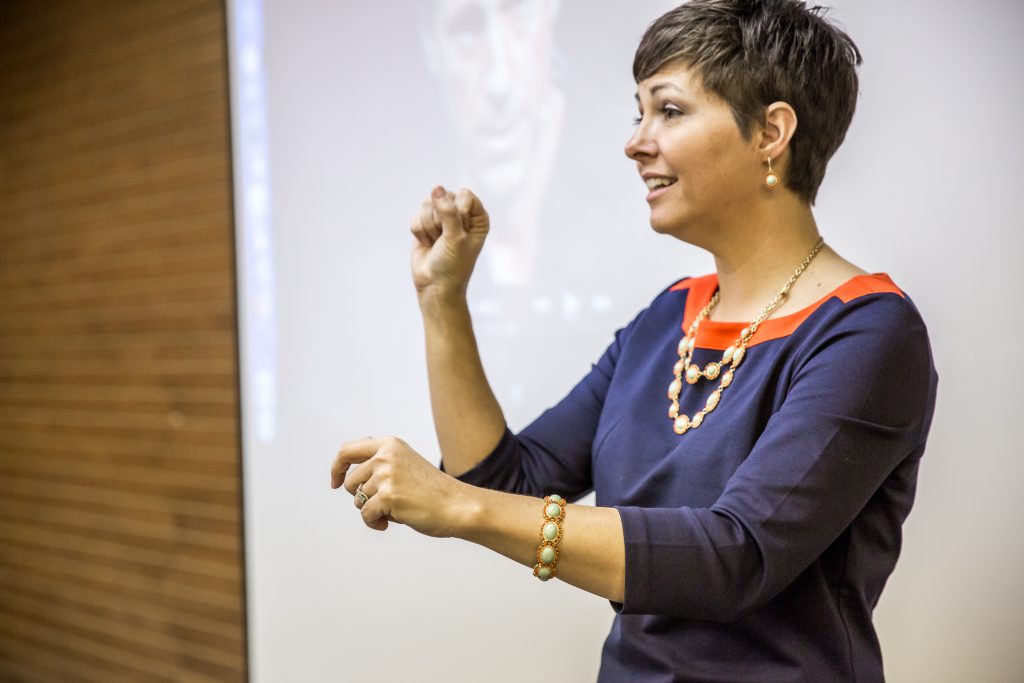
I double majored in Psychology and Interpreting, with a plan to get my master’s and Ph.D. in counseling and provide counseling to Deaf individuals. I always thought I wanted to be a counselor, but during my undergraduate degree, I discovered I preferred interpreting for counseling sessions, rather than being the counselor. Interpreting became my path.
There are so many career options for people who study sign language. I knew I didn’t want a job that was the same every day, so I decided to be a community interpreter. In this field, every day is a different job. You might be interpreting a doctor’s appointment in the morning and that afternoon interpreting for someone making computer parts at a factory. I now know enough to be dangerous on a lot of topics because of everything I have interpreted. For example, I know how to drive a backhoe (at least on paper).
As a community interpreter, the majority of my work was in the mental health setting. I enjoyed working with psychiatrists on long-term care issues and being part of the treatment team. Working with the team on how medical changes impact the way a consumer signs, provides needed information for the professionals to evaluate how medicines are impacting a consumer on a cognitive level. I am not a doctor, but as the interpreter for a consumer, I can help the medical professionals understand what is happening with a consumer’s language skills with each medicine change made. Mental health interpreting encompasses a wide variety of services and it continues to challenge my skills to find the most effective interpretations to meet a consumer’s needs.
The Deaf Community in Fulton
I decided to stay in the area after college. When you’re an interpreter, you need to live in a community with a Deaf population. While at school, I learned that Fulton is a great place to study sign language and interpreting, and a great place to work as an interpreter. The Missouri School for the Deaf is located here and there is a large Deaf community.
The more Deaf people you interact with, the better, because every Deaf person signs a little bit differently — just like people speaking English, use different buzzwords.
Back to School
I was hired as an interpreter and disability coordinator for William Woods, interpreting for Deaf students and managing interpreting needs and disability services on campus. After working for the university for seven years, I began to teach introductory interpreting classes and discovered that it was something I really enjoyed. I went on to earn my master’s degree in education from William Woods and doctorate in educational leadership and policy analysis from the University of Missouri Columbia, and have been teaching full-time at The Woods since 2005.
The William Woods ASL and Interpreting Programs
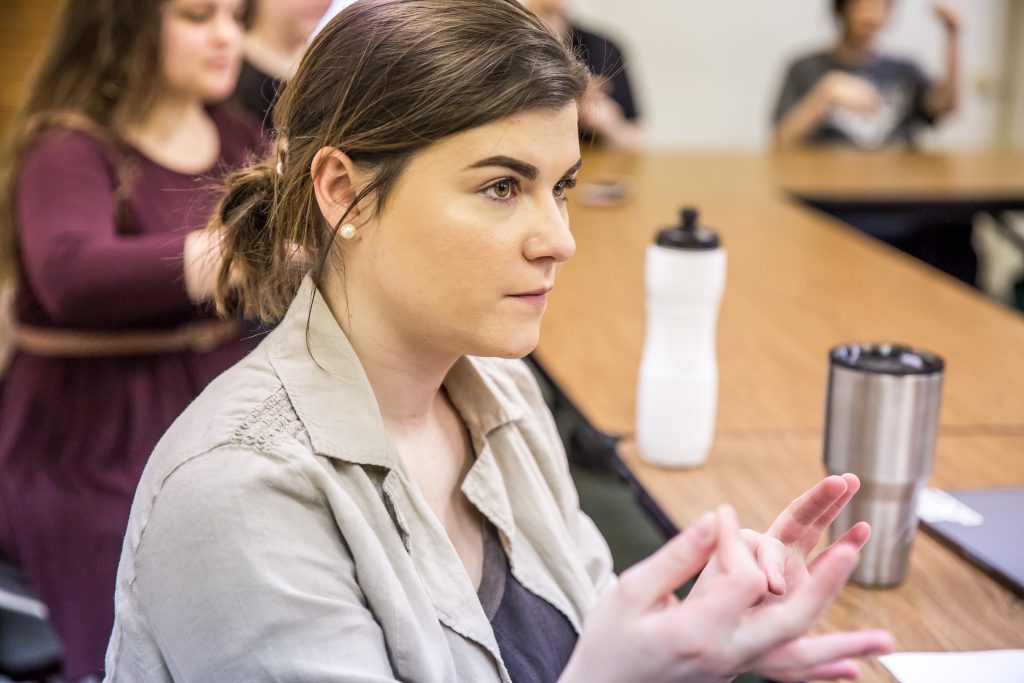
This is a very tight-knit program. We keep the classes small (at around 12 students), so you get to know your classmates and professors really well.
We’ve made quite a few changes to the curriculum over the years. We currently offer bachelor’s degrees in both American Sign Language (ASL) Studies and Interpretation Studies. You can double major in ASL and Interpreting and still finish in a four-year process, as there are classes that overlap. We can design a program for what you want it to be and for what you are going to do in the future.
At one time, it was all one four-year program. We realized that this wasn’t meeting the needs of our students. Some students came to the university already knowing sign language and didn’t need the language courses. Some students wanted to be interpreters. Some wanted to learn a little of the language for a career as an educator or social worker. This is not a one-size-fits-all field.
We split the courses into two different programs. First, you have ASL Studies, which focuses on language and culture. It’s designed to pair easily with another major, such as Psychology, Education, Business, or EQS. Having this knowledge gives you a fluency in another language. There are one million Deaf people in the United States, so knowing American Sign Language makes you more marketable.
The second program focuses on interpreting and you have to pass an ASL language test in order to enter. It focuses on the skills needed to be an interpreter and we want to make sure you have enough vocabulary to be successful. The majority of our students go out and work in the community, or work for video relay or remote interpreting. Some students also work in K–12 educational settings. Naturally, the goal is for all students to achieve certification, but many states where students are from and eventually return to, do not require certification.
Interpreting classes are very different than the ASL classes. Our ASL classes are taught by native ASL users and taught all in sign. This is the best way for students to have to learn to take in visual information. Students take several years of American Sign Language before they start taking Interpreting classes. The Interpreting classes are taught by professional interpreters who have been working in multiple settings out in the community — and still do. Interpreting courses lay out the skills needed to learn how to cognitively juggle vocabulary, meaning, and cultural implications within both the source and the intended target language. The courses scaffold the skills necessary throughout the program so that each class builds on the skills learned in the previous one.
Succeeding as an ASL/Interpreting Major
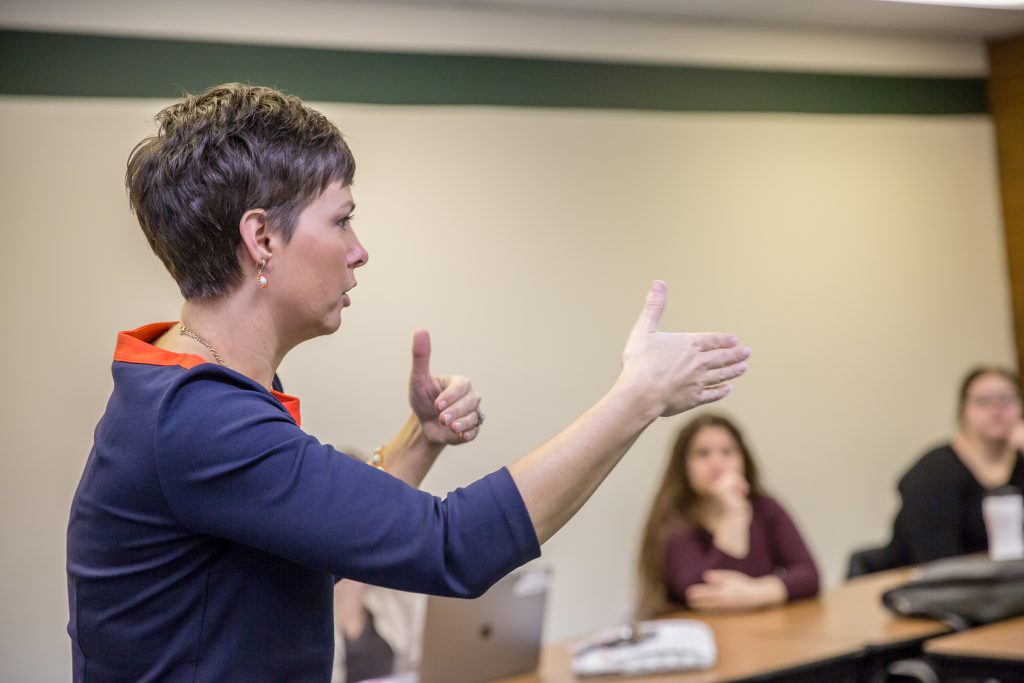
As a student, I know I was surprised to learn the amount of analysis and detail that went into the process of signing. I came in thinking that signing was pretty — and it is — but I did not have any clue as to the technical nature of the degree. The detail that goes into determining the meaning of a sentence to figure out how to interpret it accurately is tenuous. The program is a lot of work, but when students spend their time at the Missouri School for the Deaf, reading to kids or working with a sports team, it doesn’t feel like work.
It is important that students spend hours outside of the classroom working on their signing skills. They also need to work on their English vocabulary and comprehension. A student’s interpretation is only as accurate as their comprehension; if they don’t understand the message, they are not able to produce an accurate interpretation of it. We encourage students to read as much as they can and to take as many classes as possible on a variety of subjects. We interpret everything from business meetings and mental health appointments to buying a house and employment safety meetings. You name it, we are there to interpret. Students need as much general knowledge as they can get so that they are focused on how to interpret the message and not comprehending the message.
It is critical that our graduates are fluent in the language.
The students who put in the work to learn a second language are able to accomplish what it takes to be a successful interpreter. We are asking students to develop a level of fluency that is not possible if they only put in the hours in class. Out-of-class hours are essential to learning a second language. If a student only does the minimum of going to class and doing the basic homework, they will pass classes, but won’t pass certification requirements.
We have two internship courses that require a total of 300 internship hours. The internship placement can be anywhere students think they will want to work. We try to help them find an internship in a location where they can start their professional network. We have a lot of contacts in the area and I’ve been working with many of them for over a decade, so it’s easy to connect students with the right role. I also help our online interpreting students find internships around the country, which has helped grow the William Woods name. By using the internship umbrella, they can test the waters and make sure this is where they want to be before they graduate and are working professionals.
Students also need to be involved with the Deaf community. It is so important that they learn the difference between formal ASL and everyday social ASL. The more students socialize with the community, they will learn the flexibility of the language and how to use signs more effectively. The learning aspect is a benefit to socializing with the Deaf community, but the feeling of acceptance and support that this community provides is humbling.
Technology and ASL
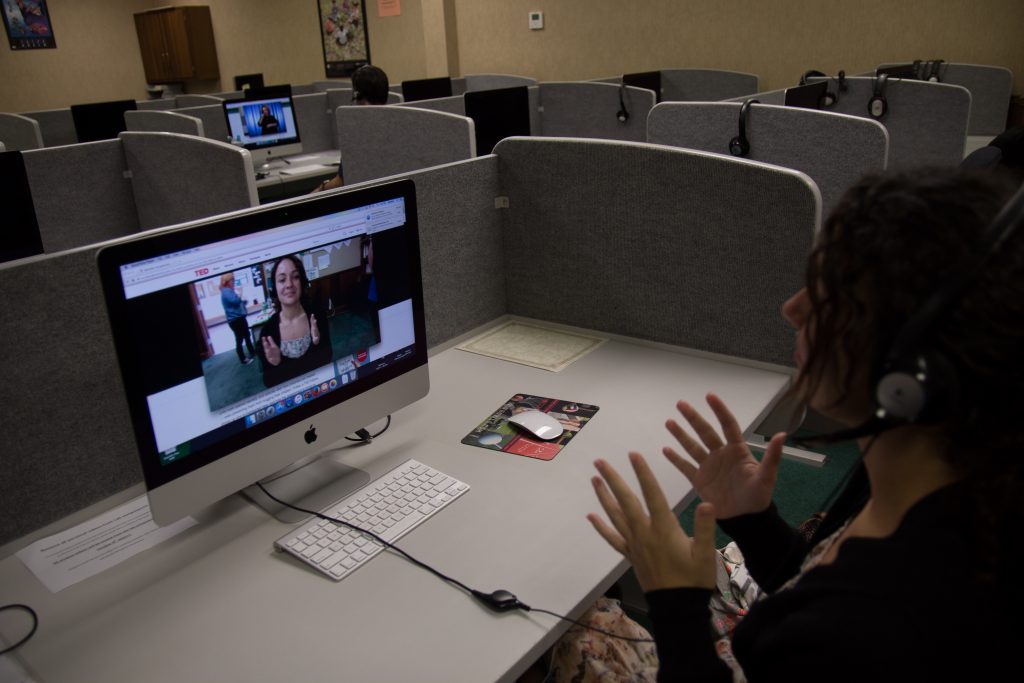
Parents often ask about the role of technology in interpreting and if technology will replace the job that we do. Simply put, no.
Technology can fingerspell and sign some basic signs, but the complex nature of communication is so culturally laden that it is almost impossible for a computer to read the consumers in the room and adjust the communication to meet the needs of everyone present. Each Deaf person signs a bit differently — just like each hearing person speaks with a different vocabulary. There are adjustments to the interpretation made all the time to ensure comprehension of the consumers in the room.
As interpreters, we do work with technology; we use technology for the Video Relay Interpreting (VRI), as well as provide Video Remote Interpreting. These special delivery methods of interpreting do not change the work that is done. The language is still communicated the same, only through the internet. VRI, simply put, is interpreting phone calls. Video Remote Interpreting is interpreting content where the Deaf consumer and hearing consumer are in the same location, but it is not possible to get an interpreter there, so the interpreter is on the screen and essentially “beamed” into the room.
The interpreting profession is retiring more interpreters annually than we have graduating from preparatory programs. This is going to be a huge problem soon.
Teaching at The Woods

My favorite part of being a professor at William Woods is the relationships I make with students and other faculty members. There is such a community here. It’s like the small Oklahoma town that I grew up in; it’s comfortable, it’s inviting, and it’s fun to work with people you like.
Some of my favorite moments with students have happened in the classroom. We have had many a day where the stress of the work was just too much and we had to stop and laugh about something, maybe an interpretation that was so off the wall we all just had to stop and appreciate how inaccurate it was. I think we have fun in class, but I know students get scared when I walk in and say that we have something “fun” to do today!
We have specific videos that students need to interpret during classes. The students see them as a rite of passage to work through them. If you’ve worked through “Filter Bubbles” or “The Coffee Video”, you’ve passed something important. The students all talk about it. Students send me pictures of things that remind them of class all the time.
It is the best feeling ever to know that they remember what we did in class and that they want to share that after they have graduated.
Something I do for every Interpreting class is take them out to eat before the final. They have put in so much work by that point that they have earned a free meal, but it is another chance for me to get to know them individually outside of the classroom. WWU is a small campus and I see students all over and chat with them, but this breakfast is one of the best conversations that I get to have with them. We don’t talk about interpreting, but what is going on in their lives, what they are doing to do over the break, their plans for the summer, etc.
I have had so many great moments with students that it is hard to talk about a few that stand out. Every time a student calls to tell me that they achieved certification or that they advanced a level in certification, I think back to their initial years in the program and about how far they have come. It is so rewarding to see them grow and take off as professionals.
| Learn more about the William Woods ASL program |

